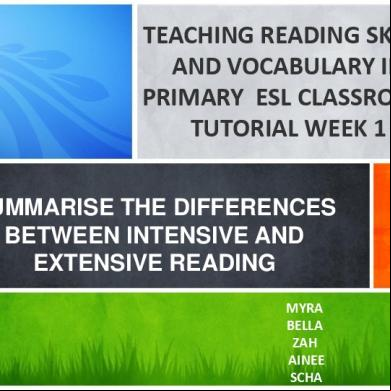Summarise The Differences Between Intensive And Extensive Reading w6d22
This document was ed by and they confirmed that they have the permission to share it. If you are author or own the copyright of this book, please report to us by using this report form. Report 3i3n4
Overview 26281t
& View Summarise The Differences Between Intensive And Extensive Reading as PDF for free.
More details 6y5l6z
- Words: 409
- Pages: 10
TEACHING READING SKILLS AND VOCABULARY IN PRIMARY ESL CLASSROOM TUTORIAL WEEK 1 SUMMARISE THE DIFFERENCES BETWEEN INTENSIVE AND EXTENSIVE READING MYRA BELLA ZAH AINEE SCHA
EXTENSIVE READING
CONTENT • Extensive reading covers large area • Extensive reading involves students reading long texts or large quantities for general understanding • It means that students are given freedom to choose their own topic .
STUDENTS’ ACTIVITIES IN CLASS. • The students, in Extensive Reading class, usually are asked to write a summary after reading an article or age about the story that they have read. • It is not easy to do as students need to take a full control on the vocabulary use, grammar and also factual data through the story.
THE USE OF DICTIONARY IN EXTENSIVE READING • Extensive reading will discourage of overuse of dictionary. (Bell, 1998) • It is because the students will be focusing more on the language if they always consult the dictionary every time they find an unfamiliar word. • Graham Stanley from British Council, Barcelona said that by avoiding dictionary, the students are expected to be encouraged to jot down the words they come across in a vocabulary notebook and they can look them up after they have finished reading.
INTENSIVE READING
CONTENT • Intensive Reading covers narrower area. • Students are not allowed to find a topic they like. • The topic is given by the teacher. • The students also do not necessary to look for ed articles because the topic which is chosen by the teacher is usually short and easy to understand.
STUDENTS’ ACTIVITIES IN CLASS. • Intensive reading, however, the activity is done usually by answering questions related to the age read. • The answers for questions given are usually from the age they have read.
THE USE OF DICTIONARY IN INTENSIVE READING
• Dictionary must be used in intensive reading. • Students have to find difficult words while they are reading. • The dictionary is often used in Intensive Reading e.g. A text will be used to answer some questions, so the students have to know the meaning of all words in the text in order to make them easy to answer the questions.
THE DIFFERENCES BETWEEN INTENSIVE AND EXTENSIVE READING INTENSIVE READING Very narrow or limited areas are covered Comprehension : Answering questions Often/ Maximized
CRITERIA
EXTENSIVE READING
CONTENT
Wide or large areas are covered
ACTIVITIES IN CLASS
Summary writing
THE USE OF DICTIONARY
Seldom/ Minimized
EXTENSIVE READING
CONTENT • Extensive reading covers large area • Extensive reading involves students reading long texts or large quantities for general understanding • It means that students are given freedom to choose their own topic .
STUDENTS’ ACTIVITIES IN CLASS. • The students, in Extensive Reading class, usually are asked to write a summary after reading an article or age about the story that they have read. • It is not easy to do as students need to take a full control on the vocabulary use, grammar and also factual data through the story.
THE USE OF DICTIONARY IN EXTENSIVE READING • Extensive reading will discourage of overuse of dictionary. (Bell, 1998) • It is because the students will be focusing more on the language if they always consult the dictionary every time they find an unfamiliar word. • Graham Stanley from British Council, Barcelona said that by avoiding dictionary, the students are expected to be encouraged to jot down the words they come across in a vocabulary notebook and they can look them up after they have finished reading.
INTENSIVE READING
CONTENT • Intensive Reading covers narrower area. • Students are not allowed to find a topic they like. • The topic is given by the teacher. • The students also do not necessary to look for ed articles because the topic which is chosen by the teacher is usually short and easy to understand.
STUDENTS’ ACTIVITIES IN CLASS. • Intensive reading, however, the activity is done usually by answering questions related to the age read. • The answers for questions given are usually from the age they have read.
THE USE OF DICTIONARY IN INTENSIVE READING
• Dictionary must be used in intensive reading. • Students have to find difficult words while they are reading. • The dictionary is often used in Intensive Reading e.g. A text will be used to answer some questions, so the students have to know the meaning of all words in the text in order to make them easy to answer the questions.
THE DIFFERENCES BETWEEN INTENSIVE AND EXTENSIVE READING INTENSIVE READING Very narrow or limited areas are covered Comprehension : Answering questions Often/ Maximized
CRITERIA
EXTENSIVE READING
CONTENT
Wide or large areas are covered
ACTIVITIES IN CLASS
Summary writing
THE USE OF DICTIONARY
Seldom/ Minimized










